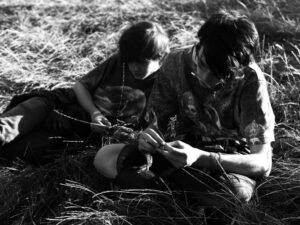
Hedi on Paris in the 90s and the music scene emerging at the time…
“Besides growing up around music, I can recall the late ‘90s when I started designing at Yves Saint Laurent and taking photographs. This was during a period of time in Paris when musicians such as Air, Daft Punk, and Phoenix were emerging. There was an energy and a sound and a spirit – a style we were sharing. It was a generational and catalytic moment for French Art in general. Everything was possible, and it was quite exhilarating. We were all experimenting with the idea and meaning of Paris, and we were all connected, an elective community.
Besides belonging to that scene, I was also drawn to what was happening in East Berlin at the time. This was 2000. I was an art resident at the Kunst-Werke, exploring and documenting Berlin’s underground and art scene, day and night. Everything seemed to happen at the same time. The early millennium felt truly like a new beginning for artists and musicians, as well as defining the contours of a new digital age.”

On the impact 9/11 had on culture and music…
“September 2001 changed everything – the dynamic, our belief that all was possible. From that moment of mourning and despair, I lost faith in a certain digital utopia which was at the heart of the creative energy and sound in Europe at the time. I went back to analog in both photography and design, and to DIY, and developed a style around it. This is when London, next to New York, started to become part of the picture.”
On stage costumes as a formative part of his design language…
“Stage costumes were a big part of my design work from the beginning. Musicians were constantly reaching out for their upcoming tours. Photography, and rock photography in particular, was something I always did in the background.
Stagewear was my introduction to men’s fashion, through album covers. My first record, besides fairy tales, was David Live in Philadelphia 1974. I probably contemplated that cover and listened to that record a million times.
The proportions, glamour and androgynous exuberance of the clothes had a strong influence on me. Beside Bowie album covers, and the Elvis 68 double leather number (’68 Comeback Special), the Ossie Clark bodysuits for Jagger were also expanding the contours of what men’s fashion could be. I would never have had any particular attraction to fashion itself if it was not for stagewear. For me it was always about music, and fashion was serving the music, enhancing the music.
I presume the musicians I knew early on, or that I met in my early days designing, and even through today, had an understanding that I was coming from music, from that perspective of the stage. They probably simply recognized themselves in my design and approached me for that reason. It was always exciting to see my clothes ending up on stage where they participated to the performance.”


